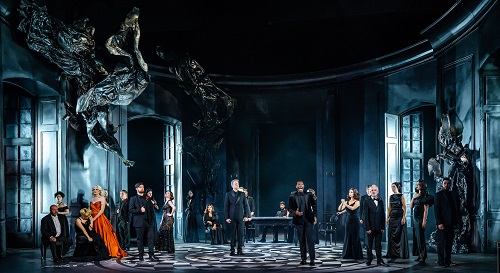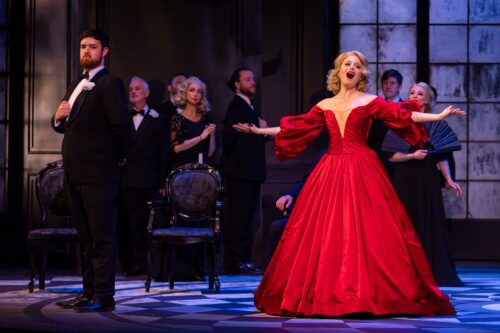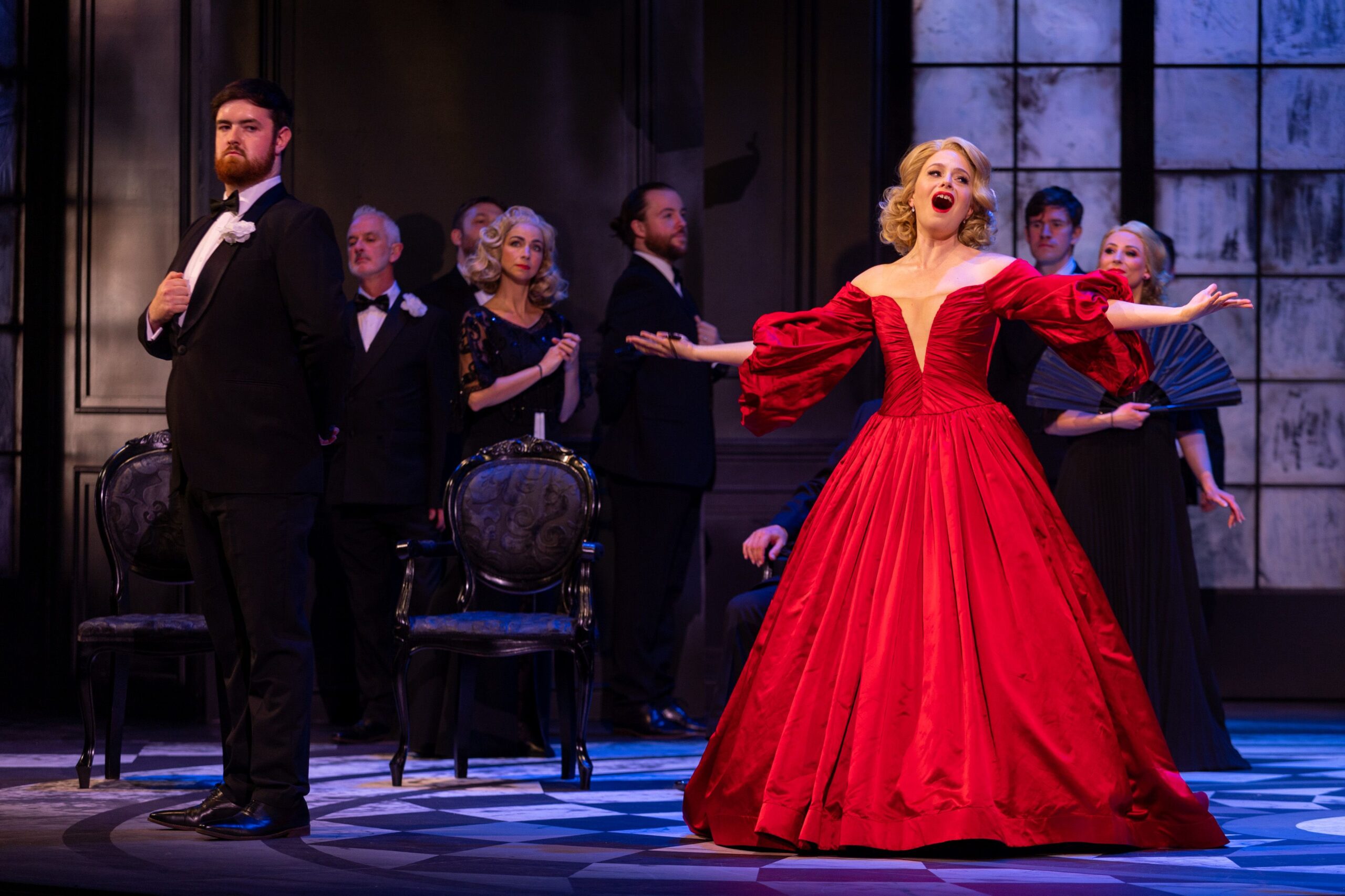 United Kingdom Verdi, La traviata: Soloists, Chorus of Northern Ireland Opera, Ulster Orchestra / Rebecca Lang (conductor). Grand Opera House, Belfast, 10.9.2022. (RB)
United Kingdom Verdi, La traviata: Soloists, Chorus of Northern Ireland Opera, Ulster Orchestra / Rebecca Lang (conductor). Grand Opera House, Belfast, 10.9.2022. (RB)

Production:
Director – Cameron Menzies
Set designer – Niall McKeever
Lighting designer – Kevin Treacy
Choreographer – Isabel Baquero
Assistant conductor and Deputy chorus master – Matthew Quinn
Cast:
Violetta Valéry – Siobhan Stagg
Alfredo Germont – Noah Stewart
Giorgio Germont – Yuriy Yurchuk
Flora Bervoix – Margaret Bridge
Annina – Ellen Mawhinney
Baron Douphol – Seamus Brady
Dr Grenvil – Graeme Danby
Gastone de Letoirières – Owen Lucas
Marchese d’Obigny – Connor Campbell
Commissioner – Ryan Garnham
Flora’s servant – Paul McQuillan
Guiseppe – Gabriel Seawright
Dancers – Doni Fierro; Adam Ashford; Clara Kerr; Anna McCoy; Sean O’Neill; Joia Raychoudhury
Cameron Menzies has followed up last year’s successful production of La bohème with this lively and colourful production of La traviata. Verdi’s masterpiece is based on the semi-autobiographical play La Dame aux Camélias by Alexandre Dumas fils. The opera tells of the tragic love affair between Violetta Valéry, a courtesan suffering from consumption, and Alfredo Germont. The opera was originally titled ‘Violetta’ after the main character, but Verdi changed it to the more evocative La traviata (‘the fallen woman’). The opera was first performed in La Fenice opera house in Venice in 1853 and it has remained a staple of the repertoire ever since.
This new production was dominated by Niall McKeever’s set which consisted of an imposing circular drawing room with an elaborately tiled floor. Decorative wraith-like features seemed to hang in the air creating an ominous portent of doom. In the opening party scene, the cast all wore black costumes injecting a dark undercurrent into the festivities. The exception was Violetta who entered wearing a stunning scarlet gown courtesy of costume designer Linda Britten. In the third Act Violetta also wore black, signalling that her demise was drawing near. Flamenco dancers performed rhythmic dance numbers in Act II (choreographed by Isabel Baquero) which enhanced the visual spectacle. The leading dancer with his matador’s cape transformed the drawing room into a bull ring which proved a fitting venue for Alfredo’s subsequent showdown with Violetta. In the final act, Violetta’s bed was placed in the centre of a bare and empty room, emphasising the solitary nature of her final days. The dancers emerged once again and whirled around Violetta in a diabolical way prior to her final reunion with Alfredo.
There was much to admire in Cameron Menzies’s production and a great deal of work had clearly gone into creating the sumptuous drawing room. Menzies successfully balanced the musical and dramatic elements and also the visual spectacle with the more heartfelt intimate moments.

Australian soprano Sobhan Stagg was superb in the role of Violetta. When she first appeared hosting a lavish party at the start of Act I and was the embodiment of social sophistication. As the production went on, we saw more and more of Violetta’s rich humanity with all its flaws, and the progressive frailty of the character. Stagg excelled in Verdi’s vocal fireworks and coloratura in Act I. ‘Sempre libera’ coursed along with infectious joy while the coquettish ornamentation in ‘Un di, felice, eterea’ was a delight. Stagg produced considerable vocal power and blazing top notes when required. In the final act her rendition of ‘Addio, del passato’ was heartbreaking and, as she finally took her leave, I doubt if there was a dry eye left in the house.
American tenor Noah Stewart gave a dramatically convincing portrayal of the love-struck Alfredo. His confrontation with Violetta in Act II had an incendiary quality while his tenderness in Act III succeeded in winning us over again. His vocal performance in Act I was a little uneven: he brought a glorious ringing quality to some of the top notes, but his intonation was not perfect. Stewart’s performance improved as the evening progressed. ‘O mio rimoroso!’ at the start of Act II was dispatched with a blaze of romantic ardour. He sang with enormous sensitivity and tenderness in the final scene as he bade farewell to Violetta.
Ukrainian baritone Yuriy Yurchuk was first-rate in the role of Alfredo’s father, Giorgio Germont. His portrayal was less severe and confrontational than others I have seen, and I would have welcomed a little more gravitas in the early part of Act II. Having said that, the scene where he persuaded Violetta to leave Alfredo was dramatically very convincing. His voice blended beautifully with Stagg in the Act II duets and his performance of ‘Di Provenza il mar’ had a smooth flowing lyricism which was enormously appealing. The rest of the cast all acquitted themselves well and I was particularly impressed with Margaret Bridge in the role of Flora, Ellen Mawhinney as Annina and Owen Lucas (Gastone) who recently won the Deborah Voight Opera Prize at the Glenarm Festival of Voice.
Rebecca Lang did an excellent job in ensuring cast, chorus and orchestra remained on track throughout the evening. I was struck by Lang’s close attention to detail and with the rich variety of textures and sonorities she coaxed from the Ulster Orchestra. The strings were highly expressive in the opening Prelude while the ensuing party music which opened the first act was full of boisterous energy. Lang and the Ulster Orchestra accompanied the singers beautifully, providing flexibility when required and adding colour to the vocal lines. The balance of sound between the orchestra and singers was spot on and at no point were the singers overwhelmed. Cast, chorus and orchestra combined well in the big set piece numbers including the famous drinking song in Act I which was greeted enthusiastically by the audience.
This was another great production from Northern Ireland Opera which deserves to be seen much more widely. The evening belonged to Siobhan Stagg who was deservedly greeted with ecstatic applause at the end of the evening.
Robert Beattie
